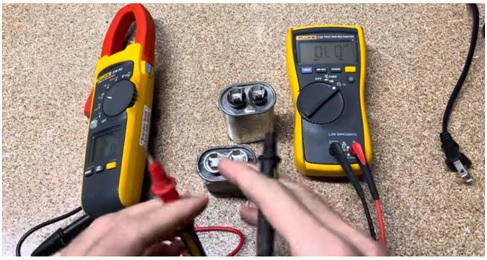To test an AC capacitor, you’ll need to purchase a multimeter, a tool used to test the voltage, current, and resistance in electrical devices. A multimeter is a small handheld device equipped with a dial, two probes, and a digital display.
These devices aren’t expensive and are available at most home improvement stores. Make sure you purchase one that allows you to test the capacitance, which is the ability to store an electric charge.
Since you’ll be working with an appliance that uses high voltage, be sure to take the proper precautions to minimize the risk of electric shock. Do not start working on the air conditioning unit until you’ve cut off power to it at the breaker. It’s a good idea to use a non-contact voltage tester to verify there is no electricity running through the unit; you can buy one at your local home improvement store for about $10.
Even after you’ve cut power to the AC unit, the capacitor will still hold a charge that’s powerful enough to hurt you. Carefully follow the instructions below to discharge it safely.

Follow the steps below to test the capacitor on your air conditioning unit. Since you’ll be working with an electrical appliance, make sure you follow each step carefully to minimize the risk of electric shock.
1.Cut Off the Power
Locate the breaker on your home’s electrical panel and cut the power to the AC unit to ensure no electricity is flowing through it while you’re testing the AC capacitor. A central AC unit will be on one of the panel’s 230-volt breakers.
2. Locate the Capacitor
Using a screwdriver, remove the access panel on your air conditioning unit. The capacitor should be easy to spot. It’s silver, cylindrical, about the size of a soda can, and has wires of various colors connected to it.
3. Release the Charge
Since a capacitor stores an electric charge, you’ll need to release that energy before you can safely work on it to eliminate the risk of shock. Use the metal end of your screwdriver to connect the capacitor’s electrical terminals to each other to release the charge.
Make sure you use a screwdriver with a plastic or rubber-insulated handle and don’t allow your hands to come into contact with any exposed metal on the screwdriver while you’re releasing the charge in the capacitor.
4. Remove the Capacitor
Now that you’ve discharged the capacitor, you can safely remove it from the AC unit. Begin by taking a picture of the wiring, so you can reinstall the capacitor after testing or replacing it. Next, unplug each of the wires connected to the capacitor, then unscrew the brackets holding the capacitor to the air conditioner and pull it out.
5. Check Its Condition
Before testing the capacitor, visually examine it. When a capacitor fails, it often bulges or leaks. If your AC’s capacitor has either symptom, you’ll need to replace it.
6. Identify the Capacitor’s Rating
You’ll need to know what you’re looking for before you can test your capacitor. Check the capacitor’s label for its microfarad (MFD) rating, which is a measurement of the amount of electricity the capacitor can store.
If you’re testing a single capacitor, you’ll find a single microfarad rating on the label. Dual capacitors have two microfarad ratings; the higher rating is for the compressor while the lower rating is for the fan motor.
Next to the microfarad ratings, you’ll also see a percentage on the label with a plus and minus sign. This percentage tells you how far off the listed microfarad ratings the capacitor can be and still function properly. For example, a capacitor with a rating of 25 microfarads and a plus or minus rating of 5% will have readings between 23.75 and 26.25 microfarads on the micrometer if it’s functioning normally.
7. Set Up the Multimeter
Turn the dial on the multimeter to the setting for capacitance. Most multimeters use the symbol –|(– to signify capacity. You should also see a uF symbol on the display, which stands for microfarads. If you’re not sure which setting on the dial to use, consult the multimeter's instructions for how to find the setting for testing capacitance. After you have the multimeter dialed in, plug the two probes into the meter’s outlets.
8. Test the Capacitor
How you test the capacitor varies depending on whether you have a single capacitor, which only has two terminals, or a dual capacitor, which has three terminals.
1) Testing a Single Capacitor
Place the first probe on one of the multimeter’s terminals and the second probe on the other terminal, then check the meter’s digital display. Compare the reading to the rating on the label to see if it's functioning normally. Don’t forget to account for the margin of error percentage.
2) Testing a Dual Capacitor
A dual capacitor provides a power boost for both the fan and the compressor and has three terminals. One terminal will be labeled “C” for common terminal, another labeled “FAN” for the air conditioner fan motor, and a third labeled either “HERM” or “COMP” for the unit’s hermetic compressor.
Start by testing the fan terminal by connecting one probe to the common terminal and one to the fan terminal. Next, test the hermetic compressor by placing one probe on the common terminal and the other on the hermetic compressor’s terminal.
Again, compare the readings to the rating on the label to see if the capacitor is functioning normally. If either the rating for the fan or compressor is off by more than the percentage listed on the capacitor label, you’ll need to replace the capacitor.